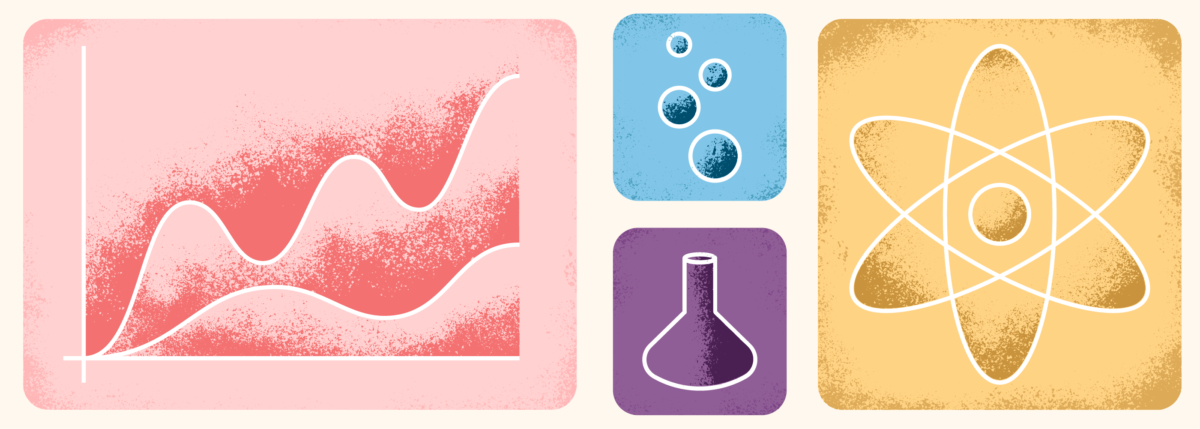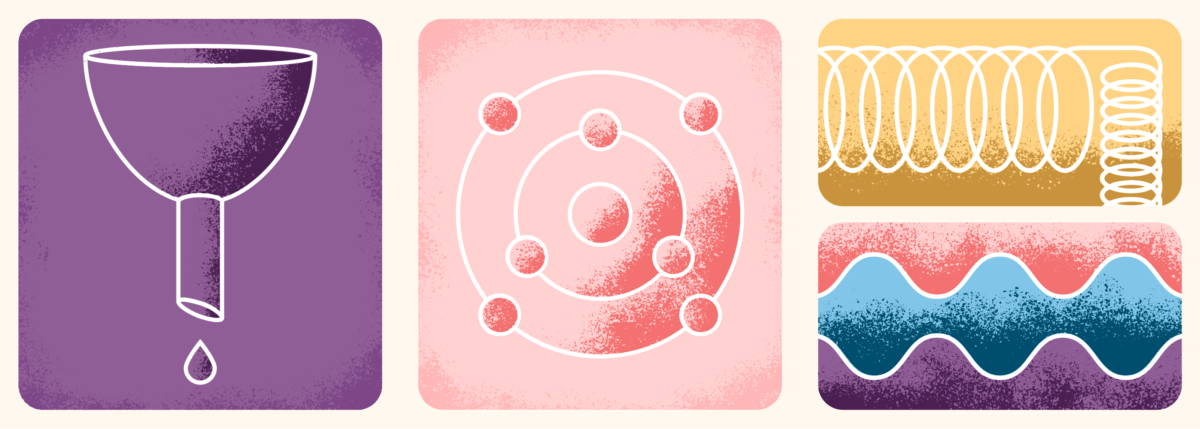Resources
The Art and Science of Beverage Architecture and Formulation
Innovation, R&D, Compliance & Science
CODO has a diverse roster of colleagues we regularly check in with to discuss trends in the beer and beverage industry. This includes brewery clients, consultants, distributors, retailers, “influencers” (I know, I know), co-packers and flavor development groups.
As we’ve previously mentioned, we especially enjoy talking shop with behind the scenes industry folks because they can corroborate what we’re seeing as possible emergent trends. Why? Because if something new and exciting (e.g. a new ingredient, style or category) is set to explode in 6 months, breweries and beverage companies are likely branding it as well as wrapping up all the other details of bringing that product to market now.
One of our favorite people to check in with on this front is Brad Nichols at Flavorman.
Flavorman is a custom beverage development company. This is the type of company you might not even imagine existing. Especially with the lore that most of Beverage Alcohol is steeped in — old guard breweries welding used dairy equipment together to make beer. Scrappy startups scaling a stove top home brew recipe to a nationally-distributed favorite. You’re great, great, great grandpa’s whiskey recipe that he developed during prohibition. Etc.
But behind this fluff marketing often lies a much more clinical path to market. An entrepreneur with an idea goes to a group like Flavorman to develop the recipe. From there, it’s chemistry lab time as the dev team creates something that tastes great, is shelf stable and repeatable at scale. This might not be as sexy as your great grandpa’s whiskey recipe, but that whiskey (or perhaps the RTD extension you’re planning that would have your (fictitious) gramps spinning in his grave) might not even be shelf stable if this leg work isn’t handled.
—
Brad’s knowledge here is somewhat overwhelming. As an example: His day job has him working his way through dozens of phone calls with potential clients. It usually takes Brad less than 10 minutes to tell someone whether or not their beverage will “work.”
Not work from a branding, marketing or sales angle. But will the ingredients you want to use and the nutritional data you want to hit and the format you want to present this all in actually be feasible to produce at scale. Will the science actually work (let alone, will you be in compliance with the law). Go or no go.
Anyway, we had a chance to sit down with Brad recently and ask a bunch of questions to better shine a light on the work that the team at Flavorman does, and how this can help you better launch your next product.
Let’s get to it.


Hi, Brad. Please introduce yourself and tell us about Flavorman.
 Brad
Brad
I’m Brad Nichols, Executive Director of Business Development at Flavorman.
Flavorman is a Custom Beverage Development company. With over 80,000 formulations and 30 years, Flavorman works hand-in-hand with our partners to Change What The World is Drinking!
With a Passion for Beverages, Books, Poetry, Story-Tellin’ and the Negroni, I have been accused of optimism as well as using the opening line: “In the Famous Words of W.C. Fields….”
Thank You for hosting and the invite Cody and Isaac, it is an absolute genuine pleasure to be joining you wonderful folks at CODO Design.

What are some of the brands that your team has helped to launch? (assuming there any you can legally name?)
 Brad
Brad
As Flavorman celebrates its 30th anniversary this year, it is a diverse, rewarding, vibrant history. Flavorman has partnered with iconic, historic brands and organizations including Brown-Forman,
Chiquita Brands and Jones Soda amongst the company’s first clients… as they say, the rest is history.
As Flavorman values our partners privacy with the highest level of Integrity, our active clients all have mutual non-disclosure agreements — yet with over 80,000 beverage formulations our work has included category leaders in every aspect of beverage: CBD, Energy, Functional, Juice, Mixer, Non-Alcoholic, Ready-To-Drink Cocktail, Seltzer, Soda, Spirit, Tea… and lots more, including those yet to come in 2023.
The story begins with the Flavoman, David Dafoe, and like every great entrepreneur Dave has fascinating stories about weathering both a business storm and success (figuratively and literally, ask him about the impact of Louisville’s flash floods during 2009 or when he first sent samples to Cincinnati and Brazil).
One of Dave’s greatest strengths has been attracting and retaining quality partners and personnel that have built Flavorman’s reputation over the past 30 years as the leader in Custom Beverage Development.
If you join us for a walking tour (we’d love to have you, Dear Reader, whoever and wherever you are), you will see products from celebrities like Jay-Z & Beyonce to Hulk Hogan’s Energy Drink to Ed Hardy to some of the first products that utilized Ginseng and Hemp—even “Better-For-You” Sodas that were well ahead of their time and would be wonderfully positioned in the natural category space today.
For any momentary breaks in décor (there will only be a couple), you will find welcome laughter and a supporting cast of characters via the great folks I call colleagues that are elated to welcome you!

There are flavor scientists, co-packers, distributors, branding firms… Where does Flavorman fit into the beverage start-up equation?
 Brad
Brad
Flavorman as a Custom Beverage Development company creates Custom Beverage Flavors, Custom Beverage Formulations and Production Manuals for our valued Partners, and that work commences with our amazing team of Flavor Scientists.
This allows me to celebrate and introduce very talented colleagues, just as I would normally introduce our new partners advancing through our business development process—meet Kristen Wemer,
Chief Technical Officer; Katie Clark, Director Research and Development; Tom Gibson, Director Flavor Architects — their incredible work, engaging with and listening to our clients as partners, creates beverages they love and are proud to take to the trade and share with their friends and family!
Next up on our walking tour of our beverage campus in Louisville, KY is Moonshine University, the “Highest Proof Education Can Buy” that offers a 6-Day Distiller Course and just recently celebrated graduating over 1,000 students. Colin Blake, Director of Spirits Education and Clay Smith, Distillery Operations Manager have assembled an incredible education program for anyone interested to advance within or learn more about the Distilling Industry.
As a technical service company, Flavorman also assists clients with Co-Packaging, Packaging and Vendor Relationships in addition to custom flavors and formulations for our valued partners.
When it comes to engaging in a beverage startup, Flavorman and Moonshine University offer a one-of-a-kind Custom Beverage Development experience.

What’s the most common problem you see with beverage ideas?
 Brad
Brad
As Humphrey Bogart said, “The problem with the whole world is everyone is a few drinks behind.” And when you’re behind, it is absolutely tempting to rush!
The most common problem I personally see with any beverage idea or emerging business is rushing.
There will be hundreds, if not thousands, of new challenges to come as a beverage entrepreneur.
Based on my personal experience in brand building, co-packaging and formulation development, I would say it is beyond important new clients take their time to evaluate all aspects of a beverage formulation, packaging and production process, as it is recommended to not rush regulatory work that accompanies US Food & Drug Administration (“FDA”) and US Tax &Trade Bureau (“TTB”) compliance as a best practice. If you are not familiar with or have not planned for a Process Authority letter (or a negative declaration) after final formulation approval process, or corrosivity testing for aluminum cans, it is very possible that you are moving too fast.
The regulatory landscape, between local, state and federal requirements can be overwhelming.
As example: Distilled Spirits packaged into aluminum cans, as ready-to-drink cocktails are fast growing in the United States, and also have specific state recycling bottle bill requirements for Can End Compliance in states such as CA, IA, HI, MA, MI, NH, NY, OR, VT. The selection of a wrong can end may lead to fines, recalls, product refusals, and a costly re-print of labels or re-planning of a production.
And Salt, via its Chloride content can be corrosive to aluminum cans, and it potentially only takes one leaking can to ruin an entire pallet of product!
As both a formulation and regulatory partner, Flavorman is here to assist our valued partners.
Anthony Bourdain, who also loved the Negroni and was very type-A valuing control in his work life, depicted eating as a “submissive experience” where you should “let your guard down and enjoy the ride.”
I would give advice to any new beverage start-up to work with hospitable, valued partners that your success is their genuine first priority as well—and when the “to-do” list becomes overwhelming, let your guard down and enjoy the ride.


Build a stronger brand.
Sell more beer.
Join 7,500+ other beer industry folks and sign up for CODO’s monthly Beer Branding Trends Newsletter.

Beer Branding Trends 2.0

Most innovation teams we work with are heavy on marketing and brand building folks vs. actual product formulation and lab emphasis. Does that mirror what you see in your day-to-day work?
 Brad
Brad
Our work at Flavorman takes our clients from Start through Finish in a Beverage Process, and that work begins with a heavy Product Formulation and Lab Emphasis for us internally, which is a fantastic resource. This allows clients to focus on both the fun and important aspects of building their brand.
“Safety” precedes “Deliciousness”—and as Beverage Architects, when helping an entrepreneur achieve their beverage dreams, that conversation often begins with parameters of Packaging and Processing.
Food Safety and Quality is always of the highest importance—every organization has core principles, “Demand Quality and Ethics” is one of our organization’s that we promote to achieve our shared vision.
When we work with a client-based innovation team, we see external innovation teams often focusing on marketing, and that is perfect as that helps guide parameters into a best formulation process.
If “Low-Calorie” is a vital marketing claim to a client’s success, we’ll talk about the Code of Federal Regulations (“CFR”) guideline that highlights 30 grams (g) or 40 calories per reference amount customarily consumed. “Calorie-Free,” “Free of Calories,” “No Calories,” “Zero (0) Calories,” “Without Calories,” and other label verbiage may be used for developments with less than 5 calories per reference amount customarily consumed.
And we’ll talk about how if you have a sweet tooth, calories are delicious!
While there is no singular path to success, we often see our most successful partners:
1. Have constant collaboration between formulation, innovation and marketing.
2. Spend extra and necessary time during their R&D process to capture unique identifiers. These can include colors, flavors, ingredients, packaging and even key label verbiage vital to marketing that separates their brand from marketplace competitors.
3. Develop co-packaging, packaging and vendor relationships as Valued Partnerships.

Traditional sugar is public enemy number one right now. What alternatives are you seeing as the most popular options for healthier sweeteners?
 Brad
Brad
Sugar will always have a home!
If a beverage-entrepreneur is looking to recreate a traditional soda of yester-year, or use the most “flavorful” sweetener for a ready-to-drink cocktail, granulated sugar can be a wonderful companion.
Non-caloric and low caloric sweeteners—e.g. Allulose, Erythritol, Monk Fruit and Sucralose, are those most often selected as replacement for beverage applications—yet it also depends on beverage category, classification, label claims, intended sales channels and the other ingredients and parameters utilized in a formulation process to make the selection of a sweetener.
Alcoholic developments, such as a grain-neutral-spirit (Vodka), will tend to accentuate the profile characteristics of a non-caloric sweetener. As example, nearly half of the U.S. population is ‘sensitive’ to the detection of Stevia, and will notice what is often associated as a “black licorice” characteristic that Stevia provides, and alcohol will accentuate that provision making the profile more noticeable.
Monk Fruit and Stevia may not be appropriately soluble for a high alcohol-by-volume development, such as a 40% ABV / 80 Proof Whiskey. Medium Invert Syrup and Liquid Sucrose can be ideal for high-ABV developments, and as a selected sweetener can also assist flocculation concerns that may arise versus the selection of a granulated sugar.
Sucralose is often a perfect sweetener for Energy Drinks, yet as it is designated as an artificial sweetener, if a client wants to develop their brands as naturally-positioned to sell their product into natural-grocers such as Erewhon, Whole Foods, Sprouts and Trader Joe’s, then Monk Fruit and/or Stevia may be perfect selections for their developments. Note: every retailer has different ingredient & label review processes.
Whether you are in Chicago, down in New Orleans, in New York City… the selection of a Sweetener should be guided by several parameters of cost, performance and positioning, and that conversation should always begin and end with Taste.

Tell me about Moonshine University. And are we sure this isn’t a National Lampoon movie from the early 80s?
 Brad
Brad
Moonshine University offers technical training and business management education for start-ups, industry professionals, and those looking for careers in the distilling industry. Courses are designed by distillery operators, industry insiders and world-renowned master distillers. Additionally, courses include but are not limited to: 6-Day Distillers; Whiskey; Route to Market; 5 Day Rum; Fermentation; Sensory for Distillers; Distilling Operations; Barrel Aging; Botanical Spirits… and additional courses & workshops.
Colin Blake, Director of Spirits Education at Moonshine University has a background in film production and comedy, so YES—there is a great chance that if you do not see Jim Belushi or Bill Murray in a class, you still will likely witness Gene Wilder somersaulting… after all, Flavorman is next door.

Who should consider going to Moonshine University?
 Brad
Brad
Moonshine University is for anyone and everyone, and those that will especially benefit include:
1. Beverage Entrepreneurs interested in operating their own distillery or launching their own brand.
2. Professionals advancing understanding of the craft, science and trade of Beverage Alcohol.
3. Anyone seeking a career in the Distilling Industry, and will also benefit for Beverage Industry.
4. Distillery Owners/Operators seeking improvements in specialized areas and practices.
5. Anyone looking to invest wisely, and prevent costly mistakes in the Beverage & Distilling Industry.
6. And last but not least… Advertisers, Artists, Beverage Entrepreneurs (in any category), Comedians, Designers, Marketers and anyone with a Passion for Beverage (…and Life!).

How often does Flavorman work with breweries? And is most of this work on Beyond Beer offerings or do you help people with beer recipes as well?
 Brad
Brad
Flavorman collaborates with breweries to develop Custom Beverage Developments, and that is a combination of Beer and “Beyond Beer” offerings—over the past couple years, growth trends have been in the “Beyond Beer” segment including Cocktails, Hard Seltzers, Wines (and Non-Alcoholic products).
Breweries have developed ready-to-drink spirit-based cocktails, mixers, ginger beer, flavored sodas and additional products to increase revenue channels for their business.
Breweries, especially craft, local and small breweries rely upon a significant portion of their draft keg sales at their taproom to drive profits, and those folks were unfortunately very affected by Covid as their restaurant and taproom was either open with a limited capacity or closed for an extended period of time.
“Beyond Beer” package offerings— via to-go taproom sales, local package store sales, online sales and home delivery capabilities have helped breweries achieve and sustain vital revenues.
Hard Seltzers that are Neutral Malt and Sugar Brew based at or under 5.9% ABV will likely have broader distribution capabilities via national grocery and c-store channels, where a Spirit-Based Cocktail that is 6% or higher may be a perfect expansion into liquor retail channels for an expanding brewery.
For breweries looking to expand Beyond Beer offerings, “where we want to sell” is just as an important consideration as is “what we want to sell”—and I’ll speak to this more with growing opportunities!


How much of your work involves helping a company scale a recipe up from a stove top / pilot batch to production levels? And just how challenging is that process?
 Brad
Brad
“Grandmother’s recipe” / “at home” / “at the bar and restaurant” / “in our kitchen”—we hear this all the time!
This is incredibly rewarding work for our team, as it allows us to help our partners commercialize their beverage dreams—and these partners will most likely have a very strong pre-existing concept and nostalgia for their beverage; they may even have an established following in their local community.
It is truly impressive to see a Custom Flavor Development process match the flavors of a homemade drink, and that process begins with sharing to us a written recipe and physical samples for us to taste.
There will always be a few concepts that are well-lived at home yet less viable or more variant in the process of commercialization.
“Switchel” and “Pickle Juice Shots” may be better suited examples to remain at home and at the bar, largely due to the fact that vinegar and the acetic acid will lead to flavor profile concerns of esterification.
And I have yet to experience anyone gently lean over and then whisper: “Grandma only used naturally-positioned low-caloric sweeteners.”

You got your start in beer: How do you feel about the current state of the beer industry?
 Brad
Brad
I will always have a soft-spot and look for the sweet-spot for Brewers and Brewery partners to grow their business—the first breweries I visited were Anchor Steam and Brooklyn Brewery with Mark Carpenter and Garrett Oliver. The first adult(-ish) books I purchased were from Charlie Papazian and Michael Jackson, The Beer Hunter. I still speak about the cultural importance of beer diversity, and will happily purchase and share Chimay, Pilsner Urquell Unfiltered, Saison Dupont and Bayerischer Bahnhof Leipziger Gose. When I hear about global price increases on aluminum and sugar, I always ask: “What about our dear friends, barley and hops?”
The Brewers Association reported U.S. beer sales volume increasing 7.9% in Craft and 8.5% in Import for 2021, with the Craft Beer Market at 21% Dollar Growth.
Beer is just as challenging and exciting as it has ever been, and just like a great restaurant, Beer has to continually be experienced through a new lens and palate.
The rise of “Hard Seltzer” since the inception of White Claw and Truly in 2016 has driven new product launches with less alcohol and calories. Hard Seltzers (as Sugar Brew and Neutral Malt seltzers) are often labeled and marketed as 5% alcohol by volume (ABV) or less and 100 calories or less. Alcohol at 5% ABV will provide an estimate 95 to 96 calories before the addition of a sweetener, so brands may add up to 2g sugar and label at 100 calories—those that add 1g or 2g Sugar (and may explore non-caloric sweeteners) will taste different than their unsweetened counterparts; preferences are up to the consumer.
In this respect, Founders All Day IPA was ahead of its time (released in 2013) and is still a market leader in providing drinkers a low(er) calorie option—in 2019 through 2021 we saw the introduction and expanded distribution of Bell’s Light Hearted Ale, Cigar City Jai Low, Dogfish Head Lo Cal, Goose Island So-Lo and several other low(er) calorie offerings versus higher-ABV IPAs as annual offerings.
The conversation for Beer does not have to be driven by calories—yet just as you highlighted Sugar now has “Wanted” and “Reward” posters around town and is a constant topic of discussion in global news, “calories” in the current market is part of the conversation more than it was ever before.
For those full-flavor counterparts that we still absolutely love—there is an opportunity for beer brands to educate new consumers on global categories and styles, to both reintroduce and change the scope of food pairings, and to always challenge and introduce new category offerings.
This Beer conversation warrants more time (…over a Beer of course)— next round is on me!

We like talking to behind the scenes folks like you because you have an idea of what’s on deck 6 to 12 months out. So, what are we looking out in the world of beverage? What flavors, what styles / products are on the horizon?
Thanks so much for your time today, Brad!
 Brad
Brad
When developing a Beverage, it is important to look at what is currently selling, and also ask yourself where the market will be in the next two to five years.
One area for research includes reports for compound annual growth rate (CAGR), where you will find Ginger Beer is expected to grow at 6.2% between 2022 to 2032 and the Hard Seltzer market is expected to increase 22.9% by 2030, with the fastest growth between 1.0% ABV and 4.9% ABV.
There is room in the current marketplace between the classic Radler (Austria’s Stiegl at 2.5% ABV) and Hard Seltzer (most often at 4.5% to 5% ABV) for additional 3% to 4% ABV products that by their alcohol content may increase Flavor, Juice and Sugar (and be at or under 100 calories). If not spoken for, I am going to go ahead and coin the terms “Hard Radler” – “Soft Seltzer” – and even “Hard Pop” (…this could work for a Pop-Punk band looking to release their own product as well ha).
Non-Alcoholic Spirits and Spirit-Inspired Alternatives are expected to grow over 5% between 2021 and 2026, and this will include expansions of TTB recognized cocktails, local offerings and emerging trends.
Bar darlings and cocktail staples will be experienced as non-alcoholic, spirit-inspired alternative offerings.
As we identified “Beyond Beer” there is also an opportunity “Before Beer” – rise of craft sodas and craft water by breweries has given us Hop Water – several of these offerings include Adaptogens, Functionals and Nootropics, including but not limited to ingredients such as Ashwagandha, CBD and L-Theanine.
Often the most sacred and unchanged, Non-Alcoholic classic and iconic brands have now launched and will continue to expand alcohol offerings – just as we have seen product launch of Barefoot Oreo Thins, Coca-Cola & Jack Daniels, Hard Mountain Dew, Monster Energy The Beast, Simply Spiked Lemonade, Stewart’s Spiked, Sonic Hard Seltzers, Topo Chico Hard Seltzer and additional offerings to come in 2023.
Ready-to-drink cocktails and spirits will continue to expand into unconventional packaging formats such as aluminum bottles, bag-in-box and other variant pouch size offerings as permitted by the TTB.
Bourbon, Gin, Rum, Tequila, Vodka and Whiskey all have a very bright future ahead of them, and citrus flavors and variants are only by limited by the imagination of the creator – exotic, tiki and tropic flavors will continue to rise in 2023, including POG (pineapple, orange, guava), mandarin and mango.
Let us of course take a moment to ask the question that is really on everyone’s mind: “When will we see the release of Hi-C Ecto Cooler Margarita with Tequila?!”
Cody and Isaac, it has been a pleasure as always.

Build a stronger brand.
Sell more beer.
Join 7,500+ other beer industry folks and sign up for CODO’s monthly Beer Branding Trends Newsletter.
